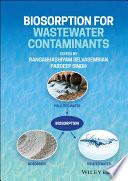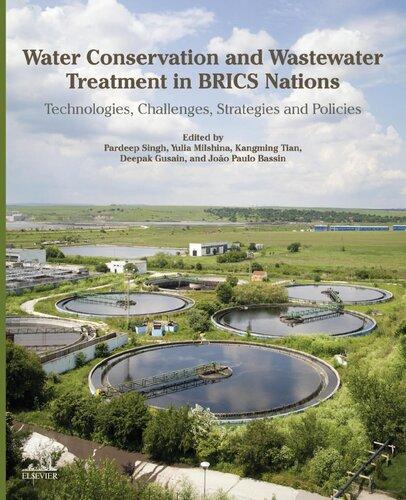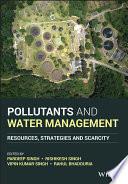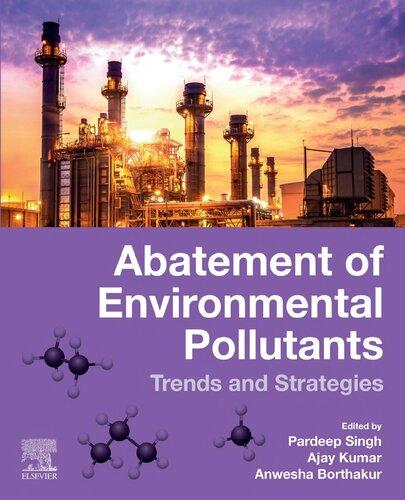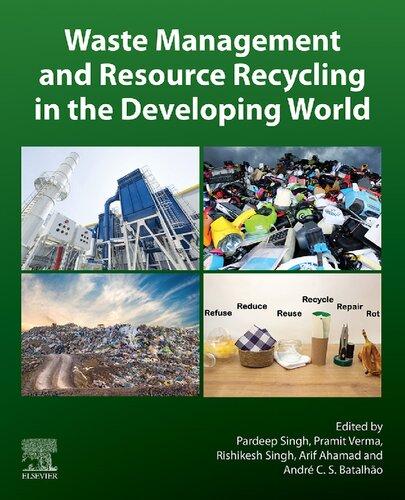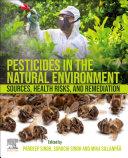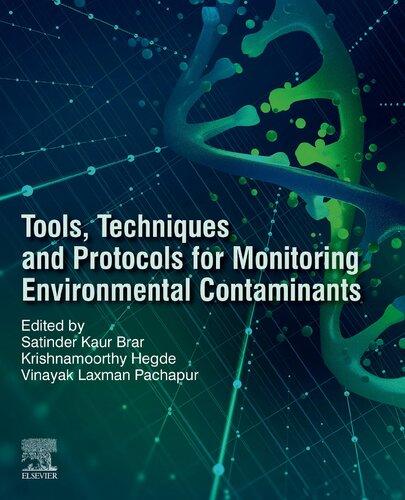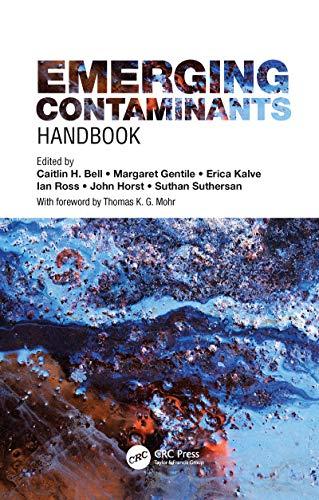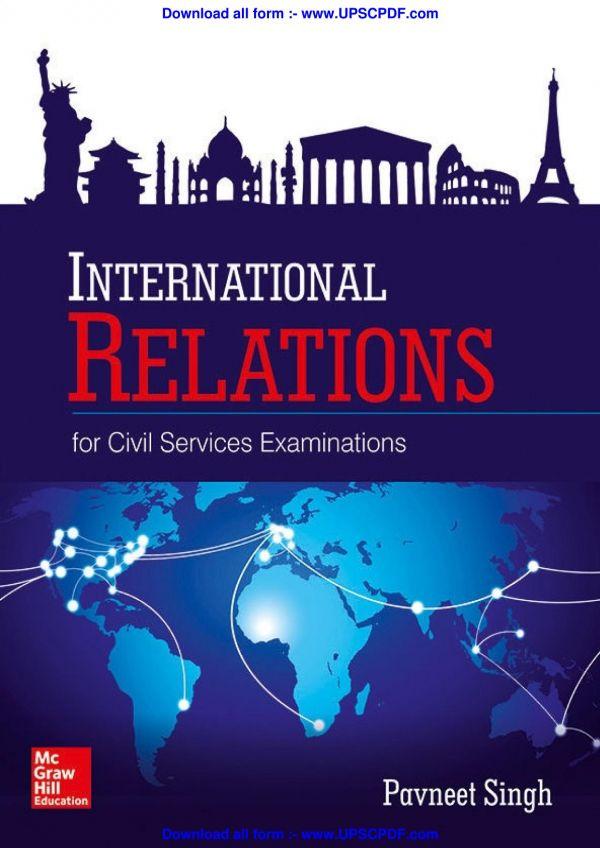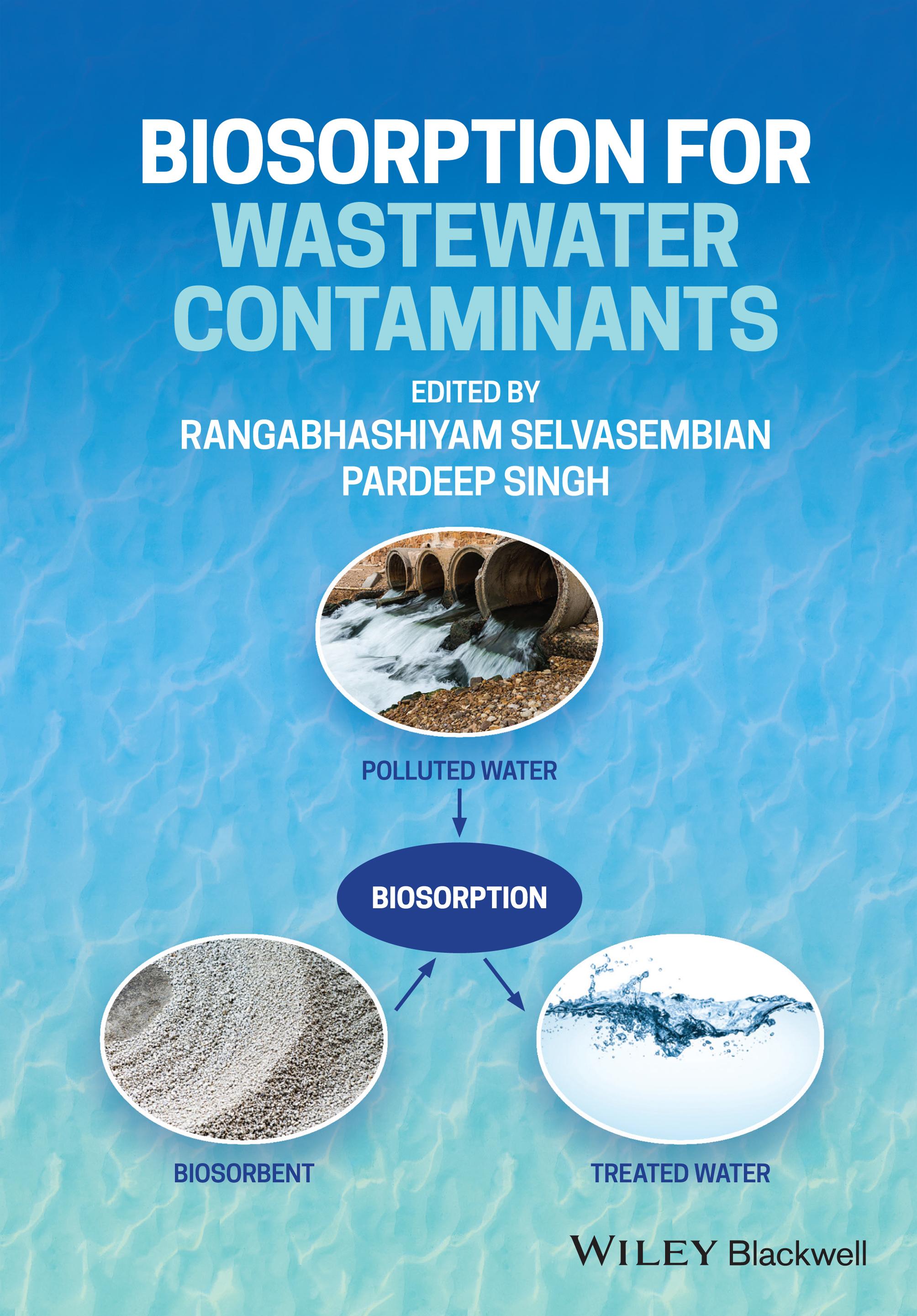Biosorption for Wastewater Contaminants
Edited by Rangabhashiyam Selvasembian
SASTRA University, School of Chemical and Biotechnology, Thanjavur, India and Pardeep Singh
PGDAV College, University of Delhi, New Delhi, India
This edition first published 2022 © 2022 John Wiley & Sons Ltd
All rights reserved. No part of this publication may be reproduced, stored in a retrieval system, or transmitted, in any form or by any means, electronic, mechanical, photocopying, recording or otherwise, except as permitted by law. Advice on how to obtain permission to reuse material from this title is available at http://www.wiley.com/go/ permissions.
The right of Rangabhashiyam Selvasembian and Pardeep Singh to be identified as the authors of the editorial material in this work has been asserted in accordance with law.
Registered Offices
John Wiley & Sons, Inc., 111 River Street, Hoboken, NJ 07030, USA
John Wiley & Sons Ltd, The Atrium, Southern Gate, Chichester, West Sussex, PO19 8SQ, UK
Editorial Office 9600 Garsington Road, Oxford, OX4 2DQ, UK
For details of our global editorial offices, customer services, and more information about Wiley products visit us at www.wiley.com.
Wiley also publishes its books in a variety of electronic formats and by print-on-demand. Some content that appears in standard print versions of this book may not be available in other formats.
Limit of Liability/Disclaimer of Warranty
In view of ongoing research, equipment modifications, changes in governmental regulations, and the constant flow of information relating to the use of experimental reagents, equipment, and devices, the reader is urged to review and evaluate the information provided in the package insert or instructions for each chemical, piece of equipment, reagent, or device for, among other things, any changes in the instructions or indication of usage and for added warnings and precautions. While the publisher and author have used their best efforts in preparing this work, they make no representations or warranties with respect to the accuracy or completeness of the contents of this work and specifically disclaim all warranties, including without limitation any implied warranties of merchantability or fitness fora particular purpose. No warranty may be created or extended by sales representatives, written sales materials or promotional statements for this work. The fact that an organization, website, or product is referred to in this work as a citation and/or potential source of further information does not mean that the publisher and author endorse the information or services the organization, website, or product may provide or recommendations it may make. This work is sold with the understanding that the publisher is not engaged in rendering professional services. The advice and strategies contained herein may not be suitable for your situation. You should consult with a specialist where appropriate. Further, readers should be aware that websites listed in this work may have changed or disappeared between when this work was written and when it is read. Neither the publisher nor author shall be liable for any loss of profit or any other commercial damages, including but not limited to special, incidental, consequential, or other damages.
Library of Congress Cataloging-in-Publication data applied for
HB ISBN: 9781119737599
Cover Design: Wiley
Cover Images: © Chanin Wardkhian/Getty images; krystiannawrocki/Getty Images; Image Source/ Getty Images
Set in 9.5/12.5pt STIXTwoText by Straive, Pondicherry, India
Contents
List of Contributors xii
Preface xvi
Foreword xvii
1 Industrial Wastewater Contaminants and Their Hazardous Impacts 1
Camila Pesci Pereira, João Pedro Neves Goldenstein, and João Paulo Bassin
List of Abbreviations 1
Introduction 2
Toxic Heavy Metals 3
Dyes 5
Oil and Grease 8
Biocides 10
Organic Compounds 12
Contaminants of Emerging Concern (CECs) 15
Conclusion 17
References 19
2 Biosorption and Different Native Sources for Preparation of Biosorbents 23
A.B. Sathya, R. Sivashankar, J. Kanimozhi, R. Devika, and R. Balaji
Introduction 23
Biosorption and Its Mechanism 24
Biosorbents 24
Types of Biosorbents 25
Microbial Biomass as Biosorbents 26
Bacterial Biomass 26
Algae as Biosorbents 27
Fungi as Biosorbents 30
Yeasts as Biosorbents 30
Biosorbents Derived from Plant and Animal Waste 31
Biocomposites 33
Alteration of Biosorbents 33
Desorption and Regeneration 34
Cost Evaluation 34
Conclusion 35
References 35
3 Biosorption for Eliminating Inorganic Contaminants (IOCs) from Wastewater 42
Rahul Sharma, Pinki Rani Agrawal, Ravi Kumar, Ittishree, and Gaurav Gupta
Introduction: Water Pollution by Inorganic Contaminants (IOCs) 42
Permissible Limits and Sources of IOCs in Water Systems 45
Standard Permissible Limits of Some IOCs in Water 45
Sources of IOCs in Water Systems 46
Natural Sources 46
Anthropogenic Sources 46
IOCs in Water: Environmental and Health Hazards 47
Elimination of IOCs from Wastewater: Recent Strategies and Remediation
Techniques 49
Oxidation/Precipitation 50
Ion Exchange 50
Electrokinetics (EK) 50
Membrane Filtration / Reverse Osmosis 50
Sorption Methods 51
Biosorption Methods for Eliminating IOCs from Wastewater 51
Concluding Remarks and Future Perspectives 54
References 56
4 Biosorption for Eliminating Organic Contaminants from Wastewater 63
Pinki Rani Agrawal, Rahul Sharma, and Abhishek Agrawal
Introduction 63
Types of Organic Pollutants and Their Effects on Human Health 64
Organic Dyes 64
Pharmaceutical Waste 66
Agricultural Waste 67
Remediation Methods for Eliminating Organic Contaminants from Wastewater 67
Biosorption as a Remediation Method for Organic Pollutants 67
Mechanism of Biosorption for Adsorption of Organic Pollutants 70
Conclusion and Future Prospects 72
References 73
5 Recent Approaches in the Preparation of Various Biosorbents 79
Rajarathinam Nithya and Arunachalam Thirunavukkarasu
Introduction 79
Biosorbents 81
Physical Treatment of Biosorbents 82
Sterilization 82
Comminution 82
Cryodessication 83
Microwave Drying 83
Chemical Treatment of Biosorbents 83
Acid Treatment 83
Alkali Treatment 84
Pyrolysis 84
Solid-Liquid Extraction 85
Immobilization 85
Chemical and Genetic Modifications 86
Challenges in the Utilization of Biosorbents 86
Conclusion 92
References 93
6 Characterization of the Biosorption Process 102
R. Sivashankar, A.B. Sathya, J. Kanimozhi, and B. Deepanraj
Introduction 102
Biosorption 103
Characterization Methods 104
Titration Technique 104
Fourier Transform Infrared Spectroscopy 105
Scanning Electron Microscopy with an Energy Dispersive X-ray
Analytical System 107
X-ray Photoelectron Spectroscopy Analysis 109
X-Ray Diffraction Analysis 110
Brunauer-Emmett-Teller Analyzer 111
Thermal Stability Analyzer 113
Conclusion 114
References 115
7 Isotherm and Kinetic Modeling Analysis of Water Decontamination through Biosorption 117
Subramanyam Busetty, Ramprasad Chandrasekaran, and Srihari Vedartham
Adsorption Equilibrium Analysis 117
Basics of Adsorption Equilibrium 117
Models of Adsorption Equilibrium 117
Two-Parameter Model 121
Langmuir Isotherm Model (Langmuir, 1918) 121
Freundlich Isotherm Model 122
Three-Parameter Models 124
Four-Parameter Models 126
Five-Parameter Model 126
Adsorption Kinetics 126
Pseudo-First-Order Kinetics 135
Pseudo-Second-Order Kinetics 136
The Elovich Equation 136
Avrami Kinetic Equation 137
Sorption Diffusion Models 137
Calculating the External Mass Transfer Coefficient 138
Intra-Particle Diffusion Control 139
Power Function Equation 140
Bangham’s Equation 140
Boyd Model 141
References 141
8 Dynamic Biosorption for Removal of Wastewater Contaminants 147
Arunachalam Thirunavukkarasu and Rajarathinam Nithya
Introduction 147
Fundamentals of Biosorption 148
Biosorbates 148
Metals 148
Organic Compounds 148
Biosorbents 149
Factors Affecting Biosorption 149
Operational Modes of Biosorption 150
Batch Biosorption 151
Dynamic Biosorption 152
Models of Dynamic Biosorption 154
Challenges in Dynamic Biosorption 159
Conclusion 161
References 162
9 Applications of Electrospun Membranes Immobilized with Biosorbents for the Removal of Contaminants 167
Noel Jacob Kaleekkal, Maheswari Purushothaman, and G Nandu
Introduction 167
Biosorption and Nanofibers 168
Electrospinning 169
Factors Influencing Electrospun Fibers 170
Advantage of Electrospinning 170
Electrospun Biosorbent Membranes 172
Immobilized Membranes for Heavy Metal Removal 173
Immobilized Membranes for Dye Removal 176
Immobilized Membranes for Removal of Organic Contaminants 176
Conclusion 178
References 178
10 Biosorption of Precious Metals from Wastewater 185
Amit Kumar Tiwari, Jay Mant Jha, and Dan Bahadur Pal
Introduction 185
Outline of Treatment Methods 188
Biosorbents 188
Biosorbents of Gold 188
Biosorbents of Silver 189
Biosorbents of PGMs (Palladium and Platinum) 190
Factors Affecting Biosorption 191
pH of the mixture 191
Operational Temperatures 191
Dosage of Biomass 192
Ionic Potency 192
Initial Concentration of the Solute 193
Rate and Period of Agitation 193
Biosorption Equilibrium Models 193
Desorption and Recovery 194
Continuous Biosorption 194
Utilization of Industrial Discharge/Wastes for Biosorption 195
Conclusions 195
References 195
11 Biosorption as a Strategy for the Recovery of Rare Earth Elements 201
João Pedro Neves Goldeinstein and João Paulo Bassin
Rare Earth Elements (REEs) 201
Methods to Recover Rare Earth Elements 204
Solvent Extraction 204
Ion Exchange 205
Adsorption 205
Chemical Precipitation 206
Biosorption 206
Biosorption Approach for Recovering Rare Earth Elements 208
Final Considerations 211
References 211
12 Deployment of Used Biosorbents in Environmental Remediation: Prospects and Challenges 213
Shashikant Shivaji Vhatkar, Guru Charan Sahu, and Ramesh Oraon
Introduction 213
Mechanism Studies 214
Adsorption 214
Ion-Exchange Resin 214
Complexation 215
Microprecipitation 215
Pyrometallurgical Processes 215
Hydrometallurgical Processes 216
Biosorption 216
Bioaccumulation and Principles 216
Biotransformation 218
Bioleaching 218
Recovery of Metals through Used Biosorbents 218
Recovery of a Single Metal with Used Biosorbents 218
Vanadium (V) 219
Chromium (Cr) 219
Nickel (Ni) 220
Copper (Cu) 220
Zinc (Zn) 221
Zirconium (Zr) 221
Ruthenium (Ru) 221
Palladium (Pd) 222
Cadmium (Cd) 222
Lanthanum (La) 223
Neodymium (Nd) 223
Rhenium (Re) 224
Platinum (Pt) 224
Gold (Au) 224
Lead (Pb) 225
Advances in Multi-Metal Recovery with Used Biosorbents 225
Adsorption Kinetics 229
Current Challenges 230
Conclusion 231
Summary 232
References 232
13 Removal of Hexavalent Chromium from Aqueous Media Using Eco-Friendly and Cost-
Effective Biological Methods 246
Veer Singh, Nidhi Singh, Priyanka Yadav, and Vishal Mishra
Introduction 246
Sources of Hexavalent Chromium 247
Toxicity of Hexavalent Chromium 247
Removal of Hexavalent Chromium Ions 248
Biosorption 250
Bioaccumulation 252
Biological Reduction of Hexavalent Chromium 255
Adsorption Kinetic Studies 259
Pseudo-First-Order Kinetics 259
Pseudo-Second-Order Kinetics 259
Adsorption Isotherm Studies 260
Langmuir Isotherm 260
Freundlich Isotherm 260
Temkin Isotherm 260
D-R Isotherm 261
Thermodynamics Studies 261
Conclusion 262
Acknowledgments 262
References 262
14 Biosorption of Arsenic from Wastewater 269
Bidhan Chandra Ruidas and Dan Bahadur Pal
Introduction 269
Sources of Arsenic in Groundwater Pollution 270
Effect of Arsenic on the Environment and Human Health 270
Methods for Removing Arsenic from Wastewater 271
Oxidation 271
Coagulation and Flocculation 271
Adsorption 272
Membrane Filtration 272
Biosorption 272
Principles of Biosorption 273
Biosorption Sites 273
Biosorption Mechanisms 274
Complexation 274
Chelation 274
Ion Exchange 274
Precipitation 275
Biosorption Isotherms 275
Biosorption Kinetics Model Analysis 276
Biosorption of Arsenic from Wastewater 277
Summary 278
Acknowledgments 278
References 278
Index 285
List of Contributors
Abhishek Agrawal
School of Pharmaceutical Sciences
Pratap University
Jaipur
Rajasthan
India
Pinki Rani Agrawal
CSIR National Physical Laboratory
New Delhi India and Academy of Scientific and Innovative Research (AcSIR)
Ghaziabad
Uttar Pradesh
India
R. Balaji
Department of Biotechnology
Aarupadai Veedu Institute of Technology
Chennai Tamilnadu
India
João Paulo Bassin
Chemical Engineering Program
COPPE
Federal University of Rio de Janeiro
Rio de Janeiro
Brazil and
Civil Engineering Program
COPPE
Federal University of Rio de Janeiro
Rio de Janeiro
Brazil
Subramanyam Busetty School of Civil Engineering
SASTRA Deemed University
Thanjavur
Tamilnadu
India
Ramprasad Chandrasekaran School of Civil Engineering
SASTRA Deemed University
Thanjavur
Tamilnadu
India
B. Deepanraj
Department of Mechanical Engineering
Jyothi Engineering College
Thrissur
Kerala
India
R. Devika
Department of Biotechnology
Aarupadai Veedu
Institute of Technology
Chennai
Tamilnadu
India
João Pedro Neves Goldenstein
Civil Engineering Program
COPPE
Federal University of Rio de Janeiro
Rio de Janeiro
Brazil
Gaurav Gupta
Department of Physics and Astrophysics
University of Delhi
New Delhi
India
Ittishree
G.V.M College of Pharmacy
Pt. B.D. Sharma University of Health Sciences
Sonipat
Haryana
India
Jay Mant Jha
Department of Chemical Engineering
Maulana Azad National Institute of Technology
Bhopal
Madhya Pradesh
India
Noel Jacob Kaleekkal
Membrane Separation Group
Department of Chemical Engineering
National Institute of Technology Calicut
Kozhikode
Kerala
India
J. Kanimozhi
Department of Biotechnology
Kalasalingam Academy of Research and Education
Krishnankoil
Tamilnadu
India
List of Contributors
Ravi Kumar
CSIR National Physical Laboratory
New Delhi
India and
Academy of Scientific and Innovative Research (AcSIR)
Ghaziabad
Uttar Pradesh
India
Vishal Mishra
School of Biochemical Engineering
IIT (BHU)
Varanasi
Uttar Pradesh
India
G Nandu
Membrane Separation Group
Department of Chemical Engineering
National Institute of Technology Calicut
Kozhikode
Kerala
India
Rajarathinam Nithya
Department of Industrial Biotechnology
Government College of Technology Coimbatore
Tamilnadu
India
Ramesh Oraon
Department of Nanoscience and Technology
Central University of Jharkhand
Brambe
Ranchi
Jharkhand
India
List of Contributors
Dan Bahadur Pal Department of Chemical Engineering
Birla Institute of Technology
Mesra
Ranchi
Jharkhand
India
Camila Pesci Pereira
Chemical Engineering Program
COPPE
Federal University of Rio de Janeiro
Rio de Janeiro
Brazil
Maheswari Purushothaman Department of Chemistry
SRM Valliammai Engineering College
SRM Nagar
Kattankulathur
Tamilnadu
India
Bidhan Chandra Ruidas Department of Chemical Engineering
Birla Institute of Technology
Mesra
Ranchi
Jharkhand
India
Guru Charan Sahu Department of Chemistry
Ranchi University
Ranchi
Jharkhand
India
A.B. Sathya
Department of Biotechnology
Aarupadai Veedu Institute of Technology
Chennai
Tamilnadu
India
Rahul Sharma
Department of Chemistry
Sabarmati University
Ahmedabad
Gujarat
India
Rahul Sharma
AcSIR
CSIR-National Physical Laboratory
New Delhi
India
Nidhi Singh Centre of Bioinformatics
University of Allahabad
Prayagraj
Uttar Pradesh
India
Veer Singh
School of Biochemical Engineering
IIT (BHU)
Varanasi
Uttar Pradesh
India
R. Sivashankar
Department of Chemical Engineering
Hindustan Institute of Technology and Science
Chennai
Tamilnadu
India
Arunachalam Thirunavukkarasu
Department of Industrial Biotechnology
Government College of Technology
Coimbatore
Tamilnadu
India
Amit Kumar Tiwari
Department of Chemical Engineering
Birla Institute of Technology
Mesra
Ranchi
Jharkhand
India
Srihari Vedartham
NICMAR
Hyderabad Campus at Shamirpet
Hyderabad
Telangana
India
Shashikant Shivaji Vhatkar
List of Contributors xv
Department of Nanoscience and Technology
Central University of Jharkhand
Brambe
Ranchi
Jharkhand
India
Priyanka Yadav
School of Biochemical Engineering IIT (BHU)
Varanasi
Uttar Pradesh
India
Preface
Today, pollution due to various anthropogenic activities has increased many times. Organic and inorganic pollutants are the most significant problem that humanity currently faces in the broad categories of water pollutants. Although several measures have been proposed and implemented to reduce these pollutants, their increasing concentration in bodies of water has created serious concerns. Over the years, the problem has been aggravated by uncontrolled industrialization and urbanization and the consequent alteration of humanity’s natural resources. The direct discharge of wastewater contaminants and their geographical mobilization have led to increased concentrations in ground, surface, and residual waters. Therefore, it is essential to understand this problem today and to control the source. In addition, extensive knowledge of detection and disposal methods is needed to develop technological solutions for various environments, including urban, rural, and urban areas.
The purpose of this book is to provide an information platform about wastewater contaminants in the current context, where researchers, engineers, and technologists working in this field face various challenges. Conventional physicochemical techniques used to remove contaminants from wastewater include ion exchange, precipitation, degradation, coagulation, coating, membrane processes, and adsorption. However, these applications have technological and economic limitations. Biomass-related precursors for the preparation of biosorbents are attracting increasing attention from researchers. Different activation approaches are used in addition to native biomass utilizations. This book deliberately minimizes basic information and focuses on sources of water pollution, biomass for biosorbent preparation, characterization of biosorbents, understanding associated biosorption mechanisms, modeling analyses of biosorption, sustainable approaches for biosorption applications, and possibilities for recovering precious metals. This book will be a key guide for environmental engineers, researchers, water authorities, and students in these fields.
Rangabhashiyam Selvasembian Pardeep Singh
Foreword
I am extremely pleased to provide the foreword to a book on biosorption that deals with the fundamentals, advancements, and future possibilities of this exciting technology. Biosorption employs the ability of biomass to adsorb different contaminants through various physicochemical mechanisms. A wide variety of biosorbents of different origins have been recognized to have high sorption capacity toward various contaminants. Biosorption mechanisms have been explored by scientists to obtain a basic understanding of the process. Nevertheless, biosorption has seldom been used for real industrial applications. The reasons are many and include lack of experimentation on real industrial effluents, multicomponent studies, and surface functionalization. Thus, a thorough compilation of the biosorption literature and a solid understanding of the biosorption technology’s essentials, progress, and potential are needed. This book, Biosorption for Wastewater Contaminants, offers the complete package.
The book comprises 14 chapters contributed by various experts in the field. Each chapter is edited carefully to provide the required information for a thorough understanding of different aspects of biosorption technology. I congratulate the editors and other contributors of this book for providing us with a complete guide to biosorption for the welfare of the research community.
Dr. K. Vijayaraghavan Senior Scientist
Department of Civil and Environmental Engineering
National University of Singapore, Singapore
Industrial Wastewater Contaminants and Their Hazardous Impacts
Camila Pesci Pereira1, João Pedro Neves Goldenstein2, and João Paulo Bassin1,2
1 Chemical Engineering Program, COPPE, Federal University of Rio de Janeiro, Rio de Janeiro, Brazil
2 Civil Engineering Program, COPPE, Federal University of Rio de Janeiro, Rio de Janeiro, Brazil
List of Abbreviations
AOP: Advanced oxidation process
ASW: Artificial sweetener
BIT: Benzisothiazolinone
BOD: Biochemical oxygen demand
BPA: Bisphenol A
BPD: Biocidal Products Directive
CD: Carbendazim
CEC: Contaminant of emerging concern
CO: Carbon monoxide
COD: Chemical oxygen demand
DBD: Dielectric barrier discharge
DCOIT: Dichloroctylisothiazolinone
DDT: Dichlorodiphenyltrichloroethane
DEET: N, N-Diethyl-meta-toluamide
DR: Diuron
EDC: Endocrine disrupting compound
EPA: US Environmental Protection Agency
FR: Flame retardant
HCB: Hexachlorobenzene
IARC: International Agency for Research on Cancer
IPBC: Iodocarb
IP: Isoproturon
IRG: Cybutryn, Irgarol 1051
MBR: Membrane bioreactor
MCI: Methyl chloroisothiazolinone
Biosorption for Wastewater Contaminants, First Edition.
Edited by Rangabhashiyam Selvasembian and Pardeep Singh. © 2022 John Wiley & Sons Ltd. Published 2022 by John Wiley & Sons Ltd.
Industrial Wastewater Contaminants and Their Hazardous Impacts
MCPP: Mecoprop
MI: Methylisothiazolinone
NOx: Nitrogen oxides
OIT: Octylisothiazolone
PAH: Polycyclic aromatic hydrocarbon
PBB: Polybrominated biphenyl
PCB: Polychlorinated biphenyl
PCP: Pentachlorophenol
PeCB: Pentachlorobenzene
PFOS: Perfluorooctanesulfonic acid
POP: Persistent organic pollutant
PPCPs: Pharmaceutical and personal care products
PPZ: Propiconazole
PT: Product type
SBR: Sequencing batch reactor
SVOC: Semi volatile organic compound
TB: Terbutryn
TBU: Tebuconazole
TOC: Total organic carbon
TOD: Total oxygen demand
VOC: Volatile organic compound
VVOC: Very volatile organic compound
WWTP: Wastewater treatment plant
Introduction
Industrial and technological development and population growth have provided countless advances in society and improved quality of life. However, the increase in production and consumption capacity also negatively impacts the planet due to emission of harmful gases and the increasing production and consequent disposal of solid wastes and wastewaters from domestic and industrial sources. The volume and concentration of contaminants present in waste streams depend on several factors such as population density, level of technological development in the country or region, climate, seasonality, etc.
Contamination of water and soil by industrial waste is a global concern. For most industries, providing access to clean, affordable water is one of the biggest challenges. In addition, industrial wastewater contains several polluting compounds (Hashemi et al., 2018; Barak et al., 2020). Thus, there is a need to establish the management of and industrial wastewaters based on strict environmental protocols, with the objective of eliminating these contaminants from the environment as much as possible. As a result, through the use of recent technologies, research has been carried out to provide intelligent solutions not only from an environmental point of view but also from an economic standpoint. Therefore, several technologies based on physical, chemical, and biological methods are investigated (Hashemi et al., 2018).
This chapter describes some of the contaminants present in industrial wastewaters, their environmental impacts, and their risks to human health. In addition, the efforts made to evaluate and define the best ways to control their dissemination in the environment are presented, as well as the treatment processes used and studied for eliminating contaminants.
Toxic Heavy Metals
Heavy metals are a classic group of metallic elements that cannot be overlooked as industrial wastewater contaminants due to their toxicity. According to the World Health Organization (WHO), some of these pollutants (e.g. arsenic, lead, mercury, and cadmium) are included in the top 10 issues of primary concern (air pollution, arsenic, asbestos, benzene, cadmium, dioxin and dioxin-like substances, inadequate or excess fluoride, lead, mercury, and highly hazardous pesticides) because they are widely spread worldwide, they are highly hazardous, and negatively affect human health and natural ecosystems (WHO, 2020). Moreover, such substances are significantly dense and persistent and have shown toxicity even at part per billion (ppb) levels (Yadav et al., 2019). Compared to other contaminants, heavy metals can be neither degraded nor destroyed and can easily accumulate along the food chain. This phenomenon, known as bioaccumulation, increases the concern about suitable methods to treat industrial wastewaters.
Heavy metals are natural constituents of the Earth’s crust, and heavy metal contamination in the environment results from natural and anthropogenic sources. Human activities are the leading causes of pollution. First, these metals are found in the form of chemical compounds or elemental state in rocks as ore deposits, which are explored through mining techniques. Environmental contamination by these compounds is not only a result of the business of mining – the largest contributor to heavy metal pollution – but may also be caused by improperly treated industrial wastewaters that reach natural ecosystems. The most common heavy metals found in industrial wastewaters are lead, cadmium, mercury, arsenic, copper, zinc, nickel, and chromium, which come from the paint, mining, metal manufacturing (electroplating, smelting, finishing, etc.), and textile industries (Akpor et al., 2014). From natural sources, the main contributions come from volcanic activity, soil erosion, and run-off. These hazardous waters deteriorate aquatic systems and terrestrial environments and retard biota growth (i.e., seed germination, chlorophyll production, and enzyme activity), with reported cases of carcinogenic, teratogenic, mutagenic, and neurotoxic effects.
There are multiple criteria to define an element as a heavy metal; however, one of the most frequently adopted classifications is based on the element’s density. Some authors define heavy metals as metals with a density greater than 4 g/cm3, while others say that the density needs to be greater than 7 g/cm3, or five times denser than water. Clearly, there is no consistency in the literature (Duffus, 2002).
Regardless of the definition, the term heavy metals is considered inadequate and obsolete, since the majority of the population misuse and misunderstand it and the term sometimes leads to confused policies and regulations. In this chapter and most discussions, such as the WHO’s list, when people refer to heavy metals, they relate heaviness to toxicity and are
actually referring exclusively to toxic metallic elements. However, in appropriate concentrations, some of these elements are vital in our daily diets, such as calcium, iron, magnesium, and zinc. Their roles are very diverse. Calcium is the primary constituent of human bones and teeth, providing structure and hardness, but it also is necessary for muscles, metabolism, and nerve responses, together with magnesium and zinc. While iron and magnesium are essential for blood production, especially hemoglobin and myoglobin, zinc supports the human immune system and male reproductive activity, and magnesium also aids in muscle recovery and sleep. Signs of illness (diarrhea, anemia, liver and kidney failure, bloody urine, vomiting) have been reported when inadequate zinc concentrations are present, which can lead to a misdiagnosis of lead poisoning (Duruibe et al., 2007). Since the main concern is not the vital concentrations of heavy metals in humans, it was decided to name this section of the chapter “Toxic Heavy Metals” to avoid any room for misinterpretation.
That being said, toxic heavy metals are a subgroup with harmful effects leading to poisoning and bio-intoxication. Some of them are dangerous at extremely low levels. For instance, the general effects of cadmium exposure in humans have been reported as renal and gastrointestinal symptoms since the body tries metabolize and eliminate the substance. However, fumes and dust can cause high levels of cadmium exposure, which compromises the respiratory tract and causes coughing and chest pain because the lungs may fill with watery fluids; the result is a high risk of death. On the other hand, long-term, low-dose exposure can be associated with osteoporosis, myocardial dysfunctions, proteinuria, and higher blood pressure (Hallenbeck, 1986; Duruibe et al., 2007). This metal is commonly associated with high-tech and power-generation components, such as batteries, alloys, solar cells, pigments, and neutron absorbers in nuclear reactors. It is also used in the automotive industry due to its corrosion resistance. Since it inhibits organism growth, like many heavy metals, it is found in phosphate fertilizers as well (Sharma et al., 2015).
Arsenic is a harmful metalloid widely distributed around the world through natural and human activities. In reported long-term, low-dose exposure, victims suffer from skin lesions, neuropathy, diabetes, cardiovascular diseases, and cancer of the skin and internal organs (WHO 2019). Arsenic can be found in drinking water, industrial processes, food, and various tobacco products. In the industrial sector, wastewaters from pesticide, glass, and pharmaceutical manufacturing may contain the metalloid, but microelectronics and optical industries also handle arsenic compounds. Arsenic has been historically used in the agricultural sector as a pesticide, an insecticide, a defoliant, and a desiccant. However, due to its high biotoxicity, the United States Environmental Protection Agency (EPA) has banned its application in crops. Furthermore, elemental arsenic is used in alloys with copper and lead, while gallium arsenide and arsine have high electron mobility and are used in superconductors, magnets, light-emitting and chips, and many other applications in the electronic industries.
On the other hand, lead is not a good electric conductor. It is used in construction, ammunition, metallic alloys, cable sheaths, lead-acid batteries, pigments, fuses, and X-ray and radiation protection. Lead-contaminated potable water causes various undesirable effects, such as anemia, kidney and brain damage, infertility, miscarriage, and changes in behavior (hypersensibility, impulsivity, and aggressiveness). Despite oral exposure being the most common, anal, dermal, respiratory, and genital routes are also possible and result
in the same kind of effects. This metal is well known for its chronic toxicity, easily damaging the central nervous system even at very low doses. In acute poisoning, the person shows signs of muscle weakness, pain, diarrhea, constipation, weight loss, bloody urine, etc. In industrial wastewaters, lead concentration ranges from 200 to 500 mg/L. According to WHO and EPA standards, its levels must be critically reduced to achieve 0.05–0.10 mg/L before discharge (Arbabi et al., 2015). In order to mitigate lead pollution, several methods for industrial wastewater treatment have been adopted, such as precipitation, adsorption, ion exchange, reverse osmosis, coagulation, and electro-coagulation (Arbabi et al., 2015).
Mercury, the only toxic metal present in liquid form at ambient temperature, is found in all living things and plays a crucial biological role. Nevertheless, it must remain at low levels, otherwise leads to toxic effects. The usual symptoms for acute exposure are fever, diarrhea, and vomiting, while chronic exposure causes tremors, nausea, stomatitis, pink disease, parageusia, and kidney malfunctions. Historically, gold amalgam (mercury alloy) was commonly used for gilding in architecture and fine arts. For example, in Saint Petersburg, Russia, at least 60 workers died from gilding the main dome of Saint Isaac’s Cathedral (Emsley, 2011). Nowadays, industrial waters containing mercury are usually associated with dental care, paints, and fertilizers, but landfill leachate must also be considered mercury-containing waste (Hargreaves et al., 2016).
There are other toxic metal compounds of great concern, such as hexavalent chromium and copper. However, these chemicals were not included in the WHO list due to fewer cases compared to the ones previously mentioned. Many of them are also genotoxic gastrointestinal disruptors and are found in fertilizers and biocide compositions. Consequently, industrial wastewater containing toxic metals must be properly treated in order to not expose humans and other animals to harmful health impacts.
Toxic heavy metals have been part of human life for quite some time; hence there have been several attempts to find the best method to effectively remove them from industrial wastewater. Conventional methods including chemical, physical, and biological mechanisms have been adopted. For inorganic wastewater, chemical precipitation and ion exchange have been most widely used, but more recent advances have shown promising results using adsorption, electrodialysis, membrane filtration, and photocatalysis (Barakat, 2011). It is noteworthy that biosorption has also shown high efficiency for removing and recovering metals from wastewater, in addition to being a much cleaner and more costeffective alternative (Kurniawan et al., 2006; Calderón et al., 2020).
Taking note of the facts and trends regarding toxic heavy metals, proper management of industrial wastewater must be taken into consideration. Each type of industry brings its own complexity and selected metals due to its manufacturing processes, as well as other constituents that must be treated before effluent discharge.
Dyes
Dyes are strongly related to toxic metals, given that they may contain such chemicals, and must be addressed. Some of their negative effects are inhibiting photosynthesis and plant growth, toxicity, carcinogenicity, mutagenicity, persistence, and recalcitrance. In addition, they increase biochemical oxygen demand (BOD) and chemical oxygen demand (COD) in
Wastewater Contaminants and Their Hazardous Impacts
industrial wastewaters (Lellis et al., 2019), which leads to further treatment expenditures. These wastewater contaminants are soluble organic compounds; because of the presence of chromophoric groups (azo, carbonyl, nitro, methine, etc.) in their molecules, it is hard to remove them from solution by conventional methods due to the presence of hydrophilic groups such as auxochromes.
Since such substances are used to color solid structures, when disposed in water bodies, they block the penetration of solar rays and reduce photosynthesis activity, which leads to lower dissolved oxygen levels and compromises aquatic life and self-purification processes. As a result, dye-containing industrial wastewater requires efficient methods to eliminate this chain of negative impacts throughout ecosystems.
Dyes can be manufactured from artificial and organic materials. Synthetic dyes are usually derived from petroleum and contain various toxic chemicals. Despite natural dyes being much more biodegradable and environmentally friendly, they must be mixed with a mordant, a kind of binding agent that helps attach dyes to fabrics. According to Katheresan et al. (2018), such binding agents may be more dangerous than synthetic dyes alone.
Over 800,000 tons of synthetic dyes are produced annually worldwide and generate around 1 trillion US dollars (Hassaan and El Nemr, 2017; Lellis et al., 2019). However, the manufacturing processes make them recalcitrant (resistant to biological degradation), and this is one of the most water-consuming sectors. For example, 1 kg of dye produced normally requires 0.15 m3 of water. Unfortunately, over 200,000 tons of these dyes are lost during coloring processes and are carried in wastewater (Chequer et al., 2012), implying an unsustainable situation. The primary use of dyes is in the textile industries, but they are also present in the paper, tannery, food, pharmaceutical, and cosmetic industries, as shown in Figure 1.1.
In the textile industry, most dyes are used for fabric coloring, especially synthetic fabrics such as polyester, polyamide, and other polymers. In this case, dyes may impact both the environment and consumers because some dyes cause allergic reactions and skin and respiratory tract irritation. When dyes are inhaled, they attack the immune system and may
Dye manufacturers
Main industries dealing with dyes. Source: Modified from Katheresan et al., 2018.
Figure 1.1
cause itchy, blocked noses, sneezing, and sore eyes. Furthermore, textile dyes are usually made of azo compounds, which are strong and complex structures made of nitrogennitrogen bonds that can be harmful even at concentrations as low as 1 part per million (ppm). To destroy such components, advanced oxidation processes (AOPs) have shown promising results, despite their high cost and sophisticated equipment requirements.
In the food industry, dyes are divided into two groups: those that require certification and those that do not. Based on the previous explanation, synthetic dyes such as azo, xanthene, triphenylmethane, and indigoid dyes are subject to a certification process (Barrows et al., 2014) due to their greater risk of toxicity. On the other hand, natural-based dyes commonly made from plants, insects, or minerals may be exempt from licensing, but their usage still needs concentration limits and attendance to levels of purity. It is worth noting that such licensing practices vary from country to country; hence, deeper understanding is necessary for any individual case. Besides the usual adverse effects listed so far, in rare cases, consuming colored foods may trigger anaphylactic shock that can cause death in minutes if proper treatment is not received, due to hypersensitivity to a dye. Any harmful effect of dyecontaining food may occur due to an individual’s intolerance or overdose of such chemicals when the food was not carefully manufactured.
In a completely different approach from how they are usually applied, dyes can be used with drugs in the pharmaceutical industry for the same purpose. Dyes are gaining credence in therapy due to their ability to engage with drug-resistant organisms, creating intolerable toxicity for microbes but not humans. A well-known example is Prontosil Rubrum® from Bayer (IG Farben Conglomerate, Germany), which behaves like a pro-drug since its reduction products are highly effective against bacterial illness, as shown in Figure 1.2. Consequently, pharmaceutical wastewaters contain, among a variety of complex, toxic, and recalcitrant compounds, dye waste from manufacturing processes and must be treated adequately before discharge.
There is a lack of complete understanding about the most effective technique for removing dyes from wastewater, and some approaches can generate by-products of secondary pollution. One of the first methods was an activated sludge process. However, although this biological process is relatively cheap and widely implemented worldwide, it is insufficient to remove such hazardous compounds (Katheresan et al., 2018). Another biological method that has achieved better removal is adsorption in biomass simultaneously with biodegradation by enzymes. Further research must take place since enzyme degradation seems to be a cheaper and safer method for dye wastewater treatment (Katheresan et al., 2018).
More expensive methods are available to treat dye wastewater using chemical and physical processes. Among the chemical methods are AOP, electrochemical destruction, ozone oxidation, ozone plus ultraviolet (UV) irradiation, etc. Unfortunately, such methods remain unattractive due to their higher investment and operational costs. On the flip side, physical methods are straightforward approaches relying on mass-transfer phenomena. These methods encompass adsorption, precipitation, cementation, coagulation, filtration, ion exchange, and reverse osmosis. Such technologies also have advantages and disadvantages and must be carefully analyzed before implementation.
After this brief review of dye wastewater and its hazardous impacts, it should be noted that the structure of dyes turns them into significant threats to the environment. With hydrophilic groups and properties that allow them to add or change color, they can
Prontosil rubrum
Sulfasalazin
Metabolism
Sulphanilamide
Metabolism
Sulfapyridine 4-Aminosalicylic acid
Sulfamethoxazole
Sulfadiazine
Figure 1.2 Prontosil and its reduction products. Source: Wainwright, 2008.
Sulfadoxine
seriously modify the environment and affect all dynamics of ecosystems. In light of this, every industry using dyes during manufacturing processes must be aware of their negative environmental impacts and properly treat wastewater before discharging it into water course.
Oil and Grease
Oil and grease (O&G) form a well-known group of wastewater contaminants including oils, waxes, grease, fats, and other compounds. Their hydrophobic property, together with lower densities compared to water, allows them to form a top layer in bodies of water that interferes with the ecosystem. Moreover, some substances in this pollutant category were found to be plant and animal growth inhibitors and may also cause mutations and cancers among exposed individuals (Odeigah et al., 1997). Similar to dye wastewater, oily wastewater normally has high COD due to its source of generation.
At first, the oily top layer may seem to be a consequence of the density difference and has only an aesthetic or recreational impact. However, this sign of contamination hinders oxygen transfer between the atmosphere and the water body, compromising the dissolved oxygen levels and, therefore, all aquatic life. Besides that, to degrade such compounds, many bacteria consume the available oxygen during their metabolization, further increasing the impact (Ekpu, 1995). If the oil comes from the petroleum industry, it may also be
inflammable and contain toxic metal and polycyclic aromatic hydrocarbons (PAHs). O&G also increase the water temperature due to their capacity to absorb solar radiation.
O&G directly and indirectly affect humans. Dermal exposure to oily wastewater can cause skin irritation and strong allergic reactions; when ingested, O&G accumulate in the liver and may cause vomiting, diarrhea, etc. But they also act indirectly, with adverse effects in ecosystems that compromise the basis of the food chain, starting from intoxicating plankton and phytoplankton and contributing to an imbalance that finally reaches the human diet. Furthermore, oily water may enter wastewater treatment plants (WWTPs) and damage pumping systems due to its viscosity, which leads to treatment failure and water and sanitation problems (Diphare et al., 2013).
Over the years, this type of contaminant is increasing in wastewater streams because of greater demand in the industrial sector and population growth. O&G are present in wastewaters from crude oil production, refineries, petrochemical industries, lubricant and cooling materials, compressor condensate, and metal processing. Domestic sewage is also a source of oily substances related to the human diet, restaurants, and car washing.
Oil in wastewater can be classified as a free oil phase, oil-water mixture, or emulsified oil mixture. As a free oil phase, droplets of oil must have a size greater than or equal to 150 microns; in oil-water mixtures, the size of oil droplets ranges from 20 to 150 microns; and in emulsified mixtures, their size is smaller than 20 microns. When the droplets are smaller than 5 microns, the oil is considered solubilized (Alade et al., 2011).
In relation to oil production, especially vegetable oil, consumption has increased much more than the population. While Brazil, the United States, the Philippines, Malaysia, and Argentina are some of the biggest producers, China consumes an enormous amount of oil by importation. The most important step in vegetable oil manufacturing and the primary cause of wastewater generation is the extraction process, which can be done chemically or mechanically. When oil is extracted mechanically, the industry uses oil mills, ram presses, or screw presses to pressurize and crush plants and seeds and obtain the desired product. Chemical extraction uses solvents such as hexane (Azad, 2018).
Despite the increasing consumption of vegetable oil, the largest producer of O&G contaminants is the petroleum industry and its refineries. Since petroleum is the world’s primary energy source and will continue to be for many years, the production of wastewaters containing O&G will remain a concern. The oily wastewater comes from upstream and downstream operations with high BOD and COD derived from fatty acids. The oil and gas industry generates significant waste streams, such as water from drilling and extraction operations in oil reservoirs, and uses water in washing, cooling, and processing operations (Odeigah et al., 1997). When a refinery has vapocracking and fluid catalytic cracking units, it generates higher volumes of wastewater. So, when refining oil, there is process water and oil-free water. The first comes from petroleum distillation, cracking, coking and viscosity reduction, and desalting, while oil-free water includes purge water from boilers, cooling water from circuits, accidentally contaminated water, stormwater, and some smaller units (Suez, n.d.).
Another kind of pollutant is lubricating grease, deriving from petroleum oils and thickened with additives. It is used in many industries to lubricate moving machinery and other heavy equipment. As a result, friction, heat, and combustion activities may transfer metals to the grease, increasing its chemical complexity or toxicity. For instance, the
combustion of heavy fuels commonly results in waste lubricants containing lead, a poisonous contaminant. From time to time, this viscous fluid needs to be replaced. Around 37 million tons of lubricants are consumed every year (Sönnichsen, 2021). Therefore, a collection system and treatment for these pollutants are necessary.
Unlike treatment processes for dye wastewater, the available methods for oily wastewater have demonstrated lower cost and complexity. There are many ways to eliminate O&G from water, including conventional, combined, and advanced technologies. According to Yu et al. (2017), conventional methods, which differ based on their separation mechanisms, are flotation, coagulation, biological treatment, and membrane filtration. On the other hand, combined technologies involve multistage processes and vary according to their studies and design. Lastly, advanced processes such as electrochemical catalysis, supercritical water oxidation, the Fenton process, ozonation, and photochemical reduction may be applied to treat wastewater containing O&G.
Biocides
A biocide is a substance or mixture that contains or generates one or more active substances to destroy, deter, render harmless, prevent the action of, or exercise control over any harmful organism by any means other than mere physical or mechanical action (ECHA, 2017).
Biocides can be used in different applications such as in-can preservatives, film preservatives, and building materials, such as coatings and wood protection products. In addition, most of these compounds have a broad spectrum of uses and application, as shown in Table 1.1 (Bollmann et al., 2014).
The European Parliament and Council directive 2013/39/EU incorporated four biocidal compounds as priority substances: cybutryne and terbutryn, diuron, and isoproturon (mentioned in Table 1.1). Diuron and isoproturon belong to the phenylureas group. Isoproturon is a component used mainly for the protection of cereals. Diuron is a herbicide present in preparations used to prevent algae growth and is also used as an additive and antifouling agent (Durak et al., 2020).
Another very relevant group of biocides is the isothiazolinones. These substances can be present in cosmetics and as chemical additives for industrial use, as they have bacteriostatic and fungistatic activities or properties. However, they may represent ecotoxicological risks because they can cause irritation and allergies. This category of biocides has aroused interest in drug development due to its biological effects, resulting in an increase in patent applications related to these substances. Isothiazolinones most commonly found in commercial applications, alone or in combination, are methylisothiazolinone (MI), methyl chloroisothiazolinone (MCI), benzisothiazolinone (BIT), octylisothiazolone (OIT) and dichloroctylisothiazolinone (DCOIT) (Silva et al., 2020).
Industrial development provides greater exposure to biocides and other contaminants, which may be discharged in many environmental matrices. The occurrence of these substances in the environment is determined by environmental conditions, physicochemical properties, and anthropogenic factors (Durak et al., 2020) and has consequences in the form of acute toxicity to aquatic organisms and accumulation of toxic substances in
